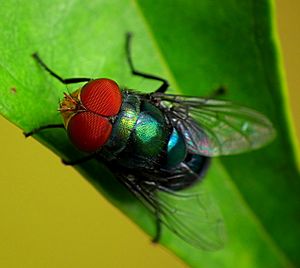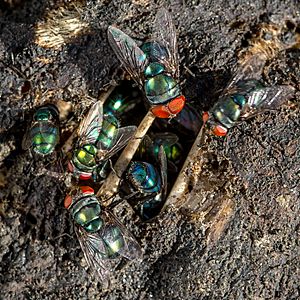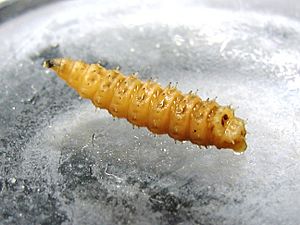Chrysomya rufifacies facts for kids
Quick facts for kids Chrysomya rufifacies |
|
|---|---|
 |
|
| Male Bluebottle Chrysomya rufifacies. | |
| Scientific classification | |
| Kingdom: | |
| Phylum: | |
| Class: | |
| Order: | |
| Family: | |
| Genus: |
Chrysomya
|
| Species: |
C. rufifacies
|
| Binomial name | |
| Chrysomya rufifacies (Macquart, 1842)
|
|
The Chrysomya rufifacies is a type of blow fly. It's also known as the hairy maggot blow fly. This fly is very important in a field called forensic entomology. This is where scientists use insects to help solve crimes, especially to figure out how long someone has been dead.
This fly likes warm weather and grows up quite quickly. You can find it in many places around the world. It often lands on large dead animals. The hairy maggot blow fly usually looks metallic green. It's important for medicine, the economy, and solving mysteries.
Contents
How Scientists Classify This Fly
Scientists group living things into categories. This helps them understand how different species are related. The Chrysomya rufifacies was first described by a French scientist named Pierre-Justin-Marie Macquart in 1842.
Its scientific name, rufifacies, comes from Latin words. Rufus means 'reddish' and facies means 'face'. So, it means 'reddish face'.
Some scientists think this fly might be the same species as another one called Chrysomya albiceps. This is because they look very similar. They also live in similar places and act alike. It can be hard to tell their young (larvae) apart. Scientists are still studying this to be sure.
What the Fly Looks Like
Adult Fly
The adult hairy maggot blow fly is easy to spot. It has a shiny, metallic blue-green color. It also has a pale area on its cheeks and a light-colored breathing hole near its head.
These flies are usually about 6 to 12 millimeters (about 0.2 to 0.5 inches) long. If you look closely with a microscope, you can see tiny hairs on its body. These hairs help scientists tell it apart from other flies. For example, the hairy maggot blow fly has a pale or white breathing hole near its head. Another similar fly, C. megacephala, has a dark brown or orange one.
Larvae (Maggots)
The young of this fly are called larvae, or maggots. They are easy to recognize because they have sharp, fleshy bumps all over their bodies. This is why they are called "hairy maggots."
When fully grown, the larvae are about 14 millimeters (about 0.55 inches) long. They have a dirty yellowish color.
Life Cycle
Understanding the life cycle of the hairy maggot blow fly is super important. It helps forensic scientists figure out how long a person has been dead. This fly has a very predictable growth time. This makes it a great tool for investigations.
Like many insects, this fly goes through a complete change, called metamorphosis. It has four stages:
- Egg
- Larva (maggot)
- Pupa
- Adult
The whole life cycle can take from about 8 to 25 days. The exact time depends on the temperature.
Female flies lay many eggs, usually around 210. They lay them near fresh dead bodies, often during the day. At about 29°C (84°F), the first tiny larva hatches from an egg in about 26 hours.
The larvae grow through three stages. At 29°C, the entire larval stage takes about 2.5 days. Maggots can even control their body temperature. They do this by moving around in a group of other maggots. This helps them stay at the best temperature for growing. Their favorite temperature is about 35.1°C (95°F).
After the larvae are done eating, they move away from the food. They look for a safe place to turn into pupae. This stage is called the prepupal stage. During this time, the larva's body gets shorter. If maggots can't move freely, their pupation might be delayed by a day. This is important for forensic scientists to remember.
The prepupal stage takes about 1.5 days. The pupal stage takes about 3 days at 29°C. During pupation, the larva's skin hardens. It forms a dark brown case called a puparium. Inside this case, the maggot changes into an adult fly.
Adult flies come out of the pupal case. They usually mate 3 to 7 days later in summer. In autumn, it takes a bit longer, about 9 to 10 days. Adult flies can live for 23 to 30 days. Females start laying eggs about 5 days after mating.
Why This Fly Is Important
Medical Uses
Believe it or not, C. rufifacies has been used in something called maggot therapy. This is a special treatment where doctors use maggots to clean wounds. They have successfully used these maggots to treat bone infections.
However, these flies can also carry germs. In some countries, they can spread bacteria and worms if they get into homes. This is because they are attracted to things like trash, meat, and even poop.
On the good side, older maggots of this fly can be helpful. They eat the maggots of other flies that spread diseases. So, they can act as a natural way to control harmful fly populations. But, some types of these maggots can cause harm if they get into wounds.
Economic Impact
The hairy maggot blow fly is found in many places. It affects farm animals and other types of flies. It's helpful because it eats the maggots of other species. This is especially true for flies that arrive first on a dead body. For example, it helps control populations of Lucilia cuprina and Lucilia sericata. These are flies that can cause problems for livestock. If there's no other food, these maggots might even eat each other!
In some places like Australia, C. rufifacies maggots can cause skin damage to sheep. This is called "sheep strike" and it costs farmers money. They can also cause problems for newborn calves and adult cattle. This happens in places like Texas and Arizona. The wounds they cause can heal slowly. But overall, this fly is not considered a major pest for livestock.
Forensic Importance
The C. rufifacies is one of the most important flies for forensic science. This is because its growth time is very predictable. This helps scientists figure out the time of death for a body. For example, the pupal stage takes about 134 to 162 hours. The adult fly starts to form around 237 to 289 hours.
These flies can also change how scientists estimate the time of death. This is because the older maggots of C. rufifacies are predators. They eat the maggots of other flies that arrive first on a body. They do this especially when there isn't much food around. Even if they don't get enough food, they can still grow into healthy adults. They can also eat younger C. rufifacies maggots. This is called cannibalism. All these actions can affect the time estimates.
In parts of the United States, adult C. rufifacies flies are among the first insects to arrive on a fresh dead body. They can show up within 10 minutes after death. Their larvae also grow faster than other species. But because they eat other maggots, they can make it tricky to estimate the time of death accurately. In Texas and Florida, these flies are often found on bodies that are in an advanced stage of decay.
Where the Fly Lives
The C. rufifacies can be found in many places where people live. It originally came from Australia. But it has been spreading rapidly to new areas. This spread happens naturally. It also happens when flies are carried by airplanes, boats, or cars.
You can find this fly from sea level up to about 2,100 meters (about 6,900 feet) high. It first appeared in the United States in the 1980s. Now, it lives in Southern California, Arizona, Texas, Louisiana, and Florida. Scientists expect it to spread to most of the United States soon. Because it spreads so fast, it has become the main blow fly found on human bodies in north and central Florida.
Future Research
The hairy maggot blow fly is very important for forensic science. It helps figure out the time of death in investigations. This fly will become even more important in the future. It is taking over from other native fly species.
Scientists are studying how this widespread fly affects the environment. For example, C. rufifacies competes with a native fly called Cochliomyia macellaria. It might even cause this native species to disappear. This fly has been very successful at competing with other species around the world. Scientists need to keep watching this fly closely. They want to understand its effects on the environment. They also want to see if it becomes more involved in causing harm to animals.
More research into how this fly develops and how it arrives on bodies will help scientists. This will allow them to make even more accurate time-of-death calculations in forensic investigations.
See also
 In Spanish: Chrysomya rufifacies para niños
In Spanish: Chrysomya rufifacies para niños



